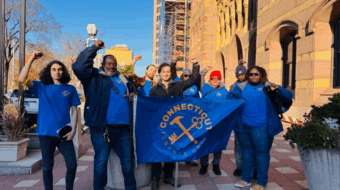
The American Federation of Labor, a national federation of labor unions in the United States, was founded at a convention in Columbus, Ohio, on December 8 in 1886. The original constituent craft unions of the AFL were disaffected from the Knights of Labor (K of L), a national labor association.
Samuel Gompers of the Cigar Makers’ International Union (CMIU), was elected president of the AFL at its founding convention and was reelected every year except one until his death in 1924. The AFL remained the largest union grouping in the U.S., even after the 1935 creation of the Congress of Industrial Organizations (CIO) by unions that left the AFL over its opposition to industrial unionism. In 1955, the AFL merged with the CIO to form the AFL-CIO, a federation which remains in place to this day as the longest lasting and most influential labor federation in the United States.
The AFL emerged out of a dispute with the K of L, whose leadership solicited locals of various craft unions to withdraw from their International organizations and to affiliate with the K of L directly. This would have taken funds from the various unions and enriched the K of L. One of the organizations embroiled in this controversy was the CMIU, which faced competition from a rival “Progressive Cigarmakers’ Union,” organized by members suspended or expelled by the CMIU. The two cigar unions vied with one another in signing contracts with various cigar manufacturers, who were at this same time combining themselves into manufacturers’ associations of their own.
In January 1886, the Cigar Manufacturers’ Association of New York City attempted to flex its muscle by announcing a 20 percent wage cut in factories around the city. The CMIU refused to accept the cut and 6000 of its members in 19 factories were locked out by the owners. A strike lasting four weeks ensued. Just when it appeared that the strike might be won, the K of L offered to settle with the 19 factories at a lower wage scale than that proposed by the CMIU, so long as only the Progressive Cigarmakers’ Union was employed.
The leadership of the CMIU was enraged, and started planning an alliance of craft unions outside the K of L as a means of defending themselves against this and similar incursions. The CMIU, the Granite Cutters, the Iron Molders, and the Carpenters invited all national trade unions to a conference in Philadelphia on May 18, stating that an element of the K of L was doing “malicious work” and causing “incalculable mischief by arousing antagonisms and dissensions in the labor movement.”
The Philadelphia conference drew the attendance of 20 delegates and letters of approval from 12 other unions. The K of L was charged with conspiring with anti-union bosses to provide labor at below going union rates and with making use of individuals who had crossed picket lines or defaulted on payment of union dues. The body authored a “treaty” to be presented to the forthcoming May 24, 1886, K of L convention, which demanded that the K of L cease attempting to organize members of International Unions into the K of L without permission of the unions involved, and that K of L organizers violating this provision should suffer immediate suspension. K of L Grand Master Workman, Terence V. Powderly, refused to seriously entertain the proposed “treaty.”
Convinced that no accommodation with the K of L was possible, the labor organizations that issued the call for the Philadelphia conference issued a new call for a convention to be held December 8, 1886 in Columbus, Ohio, in order to construct “an American federation of alliance of all national and international trade unions.” Forty-two delegates representing 13 national unions and various other local labor organizations responded to the call, agreeing to form an American Federation of Labor.
Very quickly, local labor bodies started endorsing the new AFL, and entities within the K of L departed the organization. Factional warfare broke out in the K of L, with Powderly blaming the organization’s travails on “radicals” in its ranks, while those opposing him called for an end to what they perceived as “autocratic leadership.”
The AFL showed slow but incremental growth in its first years, only cracking the 250,000-member mark in 1892. From the outset it concentrated on wages and working conditions of its membership as its almost sole focus. Participation in partisan politics was discouraged as inherently divisive, and the AFL constitution prevented the admission of political parties as affiliates.
The AFL approach relegated larger societal goals to its allies in the political sphere. The Federation favored pursuit of workers’ immediate demands rather than challenging property rights of owners, and took a pragmatic view of politics that favored tactical support for particular politicians over formation of a labor party. The AFL leadership believed the expansion of the capitalist system was seen as the path to betterment of labor, an orientation making it possible for the AFL to present itself as what one historian has called “the conservative alternative to working class radicalism.”
By 1935, as the Great Depression once again revealed some of the inherent weaknesses and contradictions in the capitalist system, the AFL craft union model came under challenge from the upstart CIO.
Adapted from Wikipedia and other sources.
Photo: Samuel Gompers in the office of the American Federation of Labor, 1887. Photo published in American Federation of Labor: History, Encyclopedia, Reference Book. Published by the American Federation of Labor, 1919. Published in USA prior to 1923, public domain. Wikimedia Commons.










